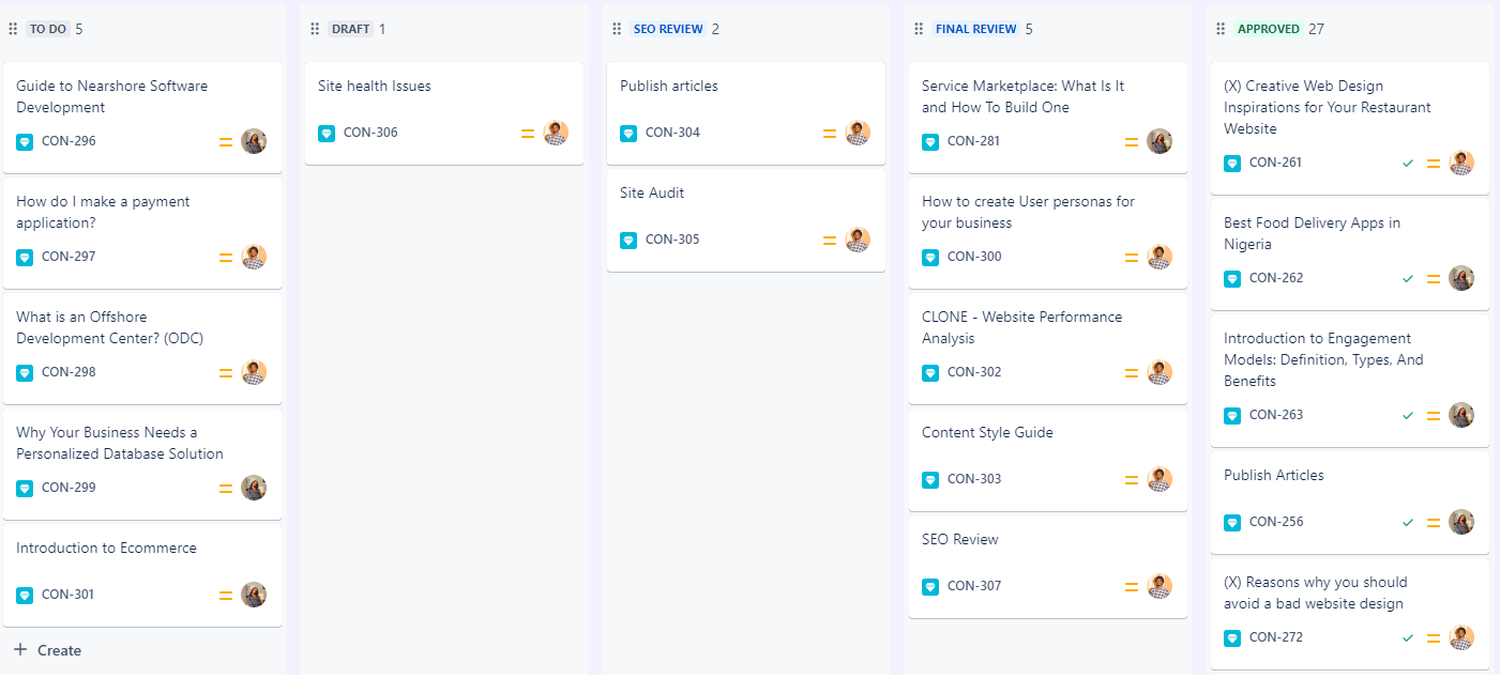Blog/Development
Task Management Board: What it is and Examples

Using software for task management is an organized way to keep track of tasks and projects. It is a preferred option over manually juggling multiple lists and papers. Imagine having to sift through piles of notes and sticky papers daily – that would take hours to sort!
However, a task management board can help you visualize your tasks, prioritize them, and track their progress more efficiently.
Learn everything you need about task management boards, including how to use one for your projects and a checklist for selecting the right project management software.
Outline
- What is a Task Management Board?
- Why Do You Need a Task Management Board?
- How to Use a Task Management Board in Project Management
- Checklist for Selecting a Task Management Board Software
- Examples of Task Management Board Apps
What is a Task Management Board?
A task management board is a physical or digital tool that facilitates monitoring a project's progress.
If it’s a physical task management board, it could be as simple as paper taped to a wall or a whiteboard. However, if it is a digital task board, it implies using a software application to organize tasks.
Regardless of the type, these boards play a crucial role in helping organizations, individuals, or teams visualize the status of tasks, including those completed, ongoing, and upcoming.
In essence, task management boards allow tasks to be represented as cards, arranged in columns or categorized according to different organizational stages or levels.
This visual representation helps monitor workflows, clearly view tasks, and share essential project information.
Task boards can also serve as a focal point for team discussions, where project changes are addressed, work is prioritized, and progress toward predefined objectives is assessed.
What is a Task Board in Project Management?
A task board in project management is a visual tool, either physical or digital, used to track the progress of tasks within a project. It typically consists of columns representing different stages of work (such as "to do," "in progress," and "done"), with tasks represented as cards or sticky notes that move across the columns as they progress.
Task boards are essentially agile tools that help teams to organize, prioritize, and monitor tasks efficiently, facilitating communication and collaboration among team members and ensuring clarity on the status of work within the project.
Why Do You Need a Task Management Board?
Having a task management board is paramount for ensuring the successful execution of projects and achieving desired outcomes. This indispensable tool serves as the cornerstone of effective project management, offering numerous benefits that contribute to enhanced team collaboration, streamlined workflows, and improved project performance. Some of these major benefits include:
Enhances Continuous Improvement: Task management boards allow teams to track tasks throughout a project, enabling them to identify when and why issues occur.
This helps teams to implement improvements, refine their planning processes, and ultimately achieve better project outcomes. For example, if a task consistently encounters delays, the team can investigate the root cause and implement strategies to prevent similar issues.
Minimizes Resource Waste: Task management boards help teams allocate resources and personnel more effectively. They allow them to optimize their workflows, reduce unnecessary work, and minimize resource waste by visualizing task dependencies and resource availability.
Fosters Collaboration Among Team Members: Task management boards provide a central space where team members can discuss work progress, identify challenges, and brainstorm solutions. This collaborative environment promotes teamwork and communication, as team members share insights, provide feedback, and support one another.
Enhances Organizational Efficiency: Task management boards help teams stay organized by visually representing tasks, priorities, and deadlines. For instance, by having a clear overview of tasks, team members can ensure that work is completed in the correct sequence and that everyone is working towards the same goals. Additionally, the board provides visibility into completed and ongoing tasks, ensuring progress is tracked and objectives are met.
Facilitates Transparency and Accountability: Task management boards promote transparency by making task status and responsibilities visible to everyone involved in the project. This transparency encourages accountability, as team members are aware of their roles and deadlines. For example, if a task is delayed or encounters difficulties, it becomes immediately apparent on the board, prompting the team to address the issue and take appropriate action.
Streamlines Decision-Making: Task management boards provide a centralized source of information, allowing teams to make informed decisions quickly.
With a clear overview of tasks, priorities, and project status, teams can identify bottlenecks, prioritize work, and adjust plans as needed.
This streamlined decision-making process ensures that the project stays on track and responds effectively to changing circumstances.
How to Use a Task Management Board in Project Management
To effectively utilize a task management board in project management, it's essential to follow these steps:
Understand Kanban or Scrum Board Principles:
Familiarize yourself with the concepts of Kanban and Scrum boards, as many task board applications use them for task organization. A kanban board divides tasks into columns like "to do," "in progress," and "done," while a scrum board categorizes tasks into assignments, in-progress, reviewing, and completed stages.
These visual methods streamline workflow management and enhance project transparency.
In all you do, ensure you choose a task board software that aligns with your project's needs and implements the preferred board type.
Tailor Board Layout to Your Processes:
When setting up your task management board, consider the specific steps in your project's workflow. Begin by identifying the key stages or phases that tasks go through from start to finish. For example, if you're managing a software development project, these stages might include requirements gathering, design, development, testing, and deployment.
So you can create columns on your task board to represent each stage. Then, as tasks are added to the board, place them in the appropriate column based on their current status. This visual representation allows team members to easily see which tasks are in progress, which ones are completed, and what still needs to be done.
Use Swim Lanes for Organization:
Swim lanes are horizontal divisions on the task board that can be used to further organize tasks based on different criteria, such as priority, team member responsible, or task type. For instance, you could create swim lanes for each team member, with tasks assigned to the respective swim lane based on who is responsible for completing them. Alternatively, you might create swim lanes to differentiate between different types of tasks, such as bug fixes, feature development, or maintenance tasks. By using swim lanes, you can add an extra layer of organization to your task board, making it easier for team members to locate and prioritize their work.
Checklist for Selecting a Task Management Board Software
Consider the following when selecting a task management board software:
Organization: Look for software that offers robust searching, filtering, and listing features to help you easily locate tasks nearing their deadlines, ensuring efficient task completion.
Task Editing: Choose software with task editing features that can enable you to monitor task status and address issues collaboratively with team members.
Integration: Ensure the task management software seamlessly integrates with other apps and tools, as this will facilitate information sharing and provide comprehensive project insights across all aspects.
User-Friendly Interface: Opt for software that is simple to set up and navigate. This will save time and motivate you and your team members to achieve project goals effortlessly.
Easy Team Member Integration: Check if the software allows for easy addition of email addresses for team members.
Visualization: Assess how well the software visualizes project progress and workflow stages. You need a task management software that guarantees a natural flow from one stage to the next for enhanced project management.
Visual Management: Ensure that managing the task board visually is intuitive. This will allow you to oversee all project aspects in one place without cumbersome navigation.
Scrum Task Board Template: Look for software that offers a Scrum Task Board template. You want to search for one that provides a ready-to-use framework for effective task management and project organization.
Examples of Task Management Board Apps
Asana is task management software that offers teams a user-friendly platform to organize, track, and collaborate on projects effectively.
With Asana, teams can create tasks, assign them to team members, set due dates, and track progress—all within a centralized workspace. Its intuitive interface and customizable features make it easy for teams to stay organized and focused on their goals.
Additionally, Asana offers various views, such as list, board, and calendar views, to accommodate different project management styles.
Monday.com is a dynamic task management board platform that excels in visualizing project workflows and streamlining team collaboration. Its flexible layout options and extensive integration capabilities make it ideal for managing diverse projects and adapting to evolving business needs.
Jira is a comprehensive task management board primarily designed for software development teams practicing agile methodologies.
It offers robust features tailored to support the entire software development lifecycle, including project planning, issue tracking, and release management.
With Jira, teams can create and organize tasks, known as issues, on customizable boards that reflect their unique workflows, such as Scrum or Kanban boards.
Airtable combines the flexibility of a spreadsheet with the functionality of a database, offering a unique approach to task management.
With its customizable views, powerful filtering options, and seamless integration with other tools, Airtable empowers teams to create tailored task management solutions that fit their specific needs.
Trello is a highly popular and user-friendly task management board that stands out for its simplicity and versatility. It utilizes a card-based system that allows users to create tasks as cards and move them across customizable boards to represent progress or different stages of a project.
Basecamp is a comprehensive project management platform that serves as a central hub for teams to collaborate, communicate, and organize their work effectively. With features such as to-do lists, message boards, file sharing, and scheduling tools,
Basecamp also provides a unified solution for project planning and execution. Its intuitive interface and user-friendly design make it easy for teams to stay organized and focused on their tasks, while its real-time updates and notifications ensure that everyone stays informed and aligned.
Getting a Bespoke solution
If your business needs a customized task management system rather than a one-size-fits-all solution, we can help you get the best fit.
At Wazobia Technologies, we craft custom software systems, such as task management boards, designed to fit your business like a glove.
With a bespoke solution, you get to call the shots. No more struggling to fit your processes into pre-made templates. We'll work closely with you to understand your requirements, preferences, and goals, then build a task management system that's perfect for you.
Plus, our systems are built to grow with your business. As you expand, we can easily add new features or integrate with your other tools. And with our focus on user-friendly design, your team will love using the system we create for you.
Contact us at [email protected] and let's build something amazing together.
Related post
Recent Posts
Need help with a project?
© Wazobia Technologies 2024
Powered by:
